Posted on 10 December 2023
When looking at the best wine regions in France, get ready for a bountiful choice. French wine regions and towns earn stellar reputations around the globe for producing the best white, sparkling, rose and red wines that are the perfect addition to fine food and dining. Of course, after a long day on the slopes, they are also ideal for sipping while sitting next to the log fire in your cosy ski chalet.
Wine lovers love the grapes that come out of French Vineyards, and France quite easily earns the title of wine capital of the world, thanks to the diversity of soil. Whether you are looking to stock up your wine cellar or want exceptional wines to relax after a day skiing the French alps, let’s look at wine production and beautiful vineyards in France, so you know which bottles to choose.
Best Wine Regions in France
Wine Experiences in The Rhone Valley
The Rhône Valley, a renowned wine region in southeastern France, is known for the diversity of soil that produces several high-quality wines. The region divides into the Northern Rhône Valley and Southern Rhône Valley, each with distinct varieties, terroir, and winemaking traditions. In the Northern Rhone valley, the Syrah red grape red grape is dominant. Wines made from Syrah in appellations like Côte-Rôtie, Hermitage, and Cornas are known for their intense, aromatic character with flavours of dark fruits, black pepper, and sometimes floral notes.
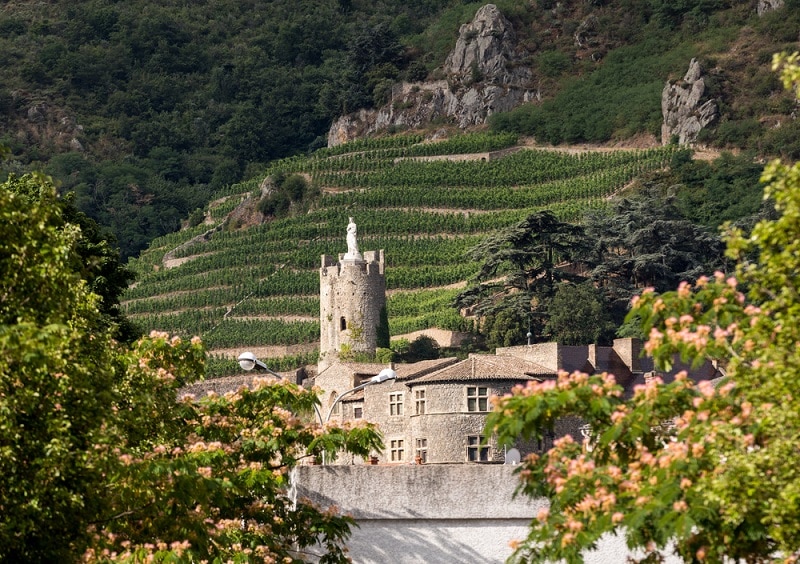
The Northern Valley also includes the Viognier white grape that produces aromatic and full-bodied white bottles. Condrieu, a famous appellation in the Northern Rhône Valley boasting 100% Viognier wines, also displays rich apricot, peach, and floral characteristics. Lastly, Marsanne and Roussanne: white varieties are often blended to produce wines in appellations such as Hermitage and Saint-Joseph. They are typically full-bodied with rich texture and honey, pear, and almond flavours.
In the Southern Rhône Valley, the Grenache red grape, is often blended with other grapes like Syrah, Mourvèdre, and Cinsault to produce wines in appellations like Châteauneuf-du-Pape, Gigondas, and Vacqueyras. These wines include bold, fruity, and spicy characters. While Mourvèdre and Syrah red grape varieties contribute structure and complexity to the blends in the Southern Rhône. Mourvèdre often adds dark fruit flavours and earthy notes, while Syrah brings peppery and meaty characteristics.
The Southern Rhône also produces some notable white bottles, often blends of Grenache Blanc, Roussanne, Clairette, and other varieties that are rich and aromatic, with flavours ranging from stone fruits to citrus and floral notes. One unique aspect is using “GSM” to describe red blends, which stands for Grenache, Syrah, and Mourvèdre. These three grape varieties are frequently combined to create well-balanced and flavourful bottles.
The Beautiful Wine Region of Burgundy
Burgundy, or Bourgogne in French, is one of Frane’s most prestigious and historic French wine regions. Saint Emilion, a medieval village and UNESCO World Heritage site is strongly recommended, and other landmark towns are worth noting. The region’s specific characteristics of soil, climate, and varieties are intimately tied to the quality and style.
Additionally, south of Burgundy is home to the famous Beaujolais Nouveau wine, which only sells in November. Burgundy might have a more prolonged harvest than other regions due to cold winters, yet this doesn’t deter from taste.
Look for anything from Ch’teau Philippe le Hardi, but Burgundy earns fame for the Pinot Noir grape, often described as elegant, aromatic, and expressive, with flavours ranging from red berries to earthy and floral notes. White bottles from Burgundy are predominantly made from Chardonnay. Depending on the specific terroir, the region produces various Chardonnays, from crisp and mineral to rich and buttery.
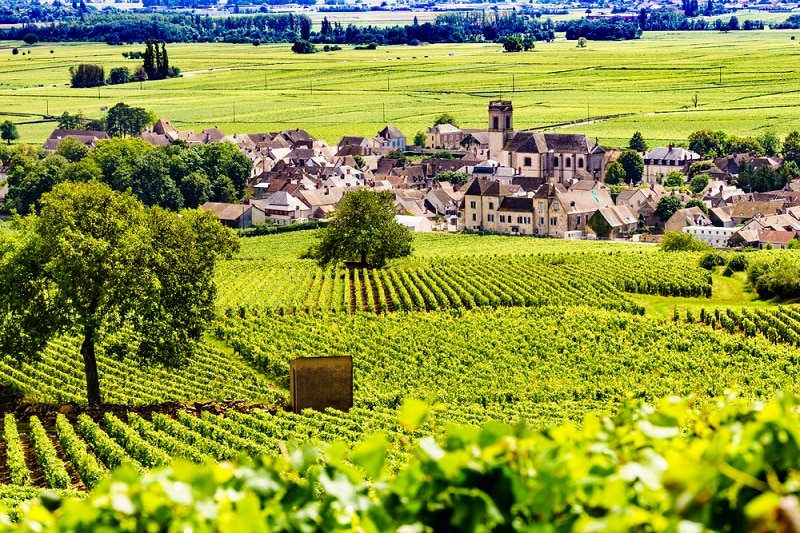
Burgundy uses a complex classification system based on the AOC (Appellation d’Origine protegee) system. The region has several sub-regions, each with specific regulations and characteristics.
- Côte d’Or: This region is further divided into Côte de Nuits and Côte de Beaune, renowned for producing exceptional Pinot Noir and Chardonnay.
- Chablis: Located northwest of Côte d’Or, Chablis excels in crisp and mineral-driven Chardonnay.
- Côte Chalonnaise: South of Côte d’Or, this region produces high-quality bottles at more accessible prices.
As well as featuring cute villages, Burgundy includes numerous domaines and producers, many of which are small, family-owned operations. Some prestigious domaines include Domaine de la Romanée-Conti, Domaine Leroy, and Domaine Leflaive.
Loire Valley for Your Favourite Wine
The Loire Valley, a famous wine region in central France, features charming cities, cute villages, and several wines. Loire Valley, the third-largest wine-producing region in France, is recognized for versatility, producing everything from crisp, dry whites to sparkling and sweet dessert wines. If you visit, stop by Ch’teau De Tracy for fantastic wine tours. Another place to sample wine is Bouvet Ladubay.
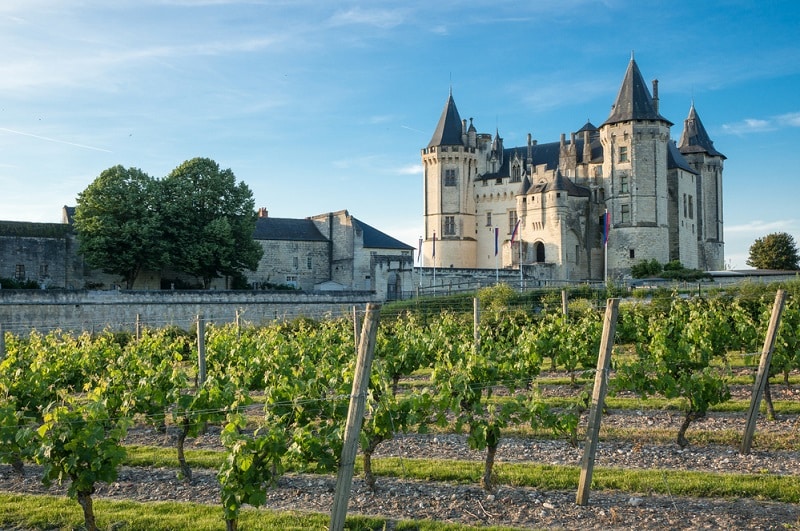
Sauvignon Blanc: The Loire Valley excels in Sauvignon Blanc bottles, particularly from the Central Vineyards region. Sancerre and Pouilly-Fumé are well-known appellations producing vibrant, mineral-driven Sauvignon Blancs with citrus and herbal notes.
Chenin Blanc: Chenin Blanc, a versatile grape found in several Loire Valley appellations, produces dry to sweet whites in the Anjou and Saumur regions. Vouvray, a prominent appellation, produces Chenin Blanc bottles that range from dry and crisp to lusciously sweet.
Cabernet Franc: This red grape variety thrives in Chinon, Bourgueil, and Saumur-Champigny. Loire Valley Cabernet Franc features freshness, red fruit flavours, and sometimes peppery or herbal notes.
Melon de Bourgogne: Mainly associated with the Muscadet region at the western end of Loire Valley, Melon de Bourgogne produces crisp and mineral-driven white bottles, especially Muscadet.
Sparkling Wines: The Loire Valley’s sparkling wines are primarily produced in the Touraine region. Crémant de Loire is a famous sparkling wine made using traditional methods, and it can be produced from various grape varieties.
Sweet Wines: Besides dry and sparkling wines, the Loire Valley is celebrated for sweet wines, particularly those made from Chenin Blanc affected by noble rot (botrytis). Quarts de Chaume and Coteaux du Layon are two appellations famous for their sweet and luscious dessert wines.
Sub-Regions and Appellations
- Sancerre, and Pouilly-Fumé are Known for Sauvignon Blanc wines with excellent minerality and acidity.
- Anjou-Saumur produces several wine styles, including dry, sweet, and sparkling wines. Chenin Blanc and Cabernet Franc are prominently featured.
- Touraine is a diverse region with white, red, and rosé wines, including Sauvignon Blanc, Chenin Blanc, and Cabernet Franc.
- Located near the Atlantic coast, Muscadet specializes in white wines made from Melon de Bourgogne, offering crisp and refreshing options.
Charming Towns in the Alsace Region of France
In northeastern France, Alsace is a unique and distinct wine region of typical villages and aromatic, expressive white bottles. The region has a long history of winemaking, and Alsatian villages are celebrated for producing wines that showcase the characteristics of individual grape varieties. Many wine tours cover the main Alsatian villages that make the best wine, and the Muscat d’Alsace comes highly recommended. Additionally, the location on the border means many wines have German influence.
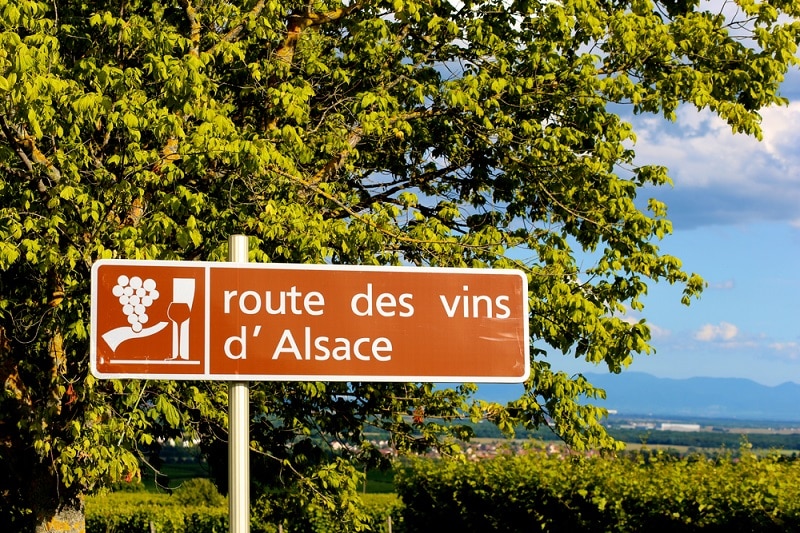
Alsace Pinot Gris are rich, full-bodied, and often off-dry. They showcase flavours of ripe stone fruits, honey, and sometimes a hint of smokiness. Pinot Gris from Alsace provides a versatile range of styles, from dry to sweet. Alsace is also known for both Muscat Blanc à Petits Grains (aromatic) and Muscat Ottonel (less aromatic) varieties.
Muscat bottles from Alsace are typically dry and express floral and grapey aromas. Alsace Pinot Blanc wines are fresh, crisp, and approachable. Sylvaner is a lighter-bodied white grape variety, and while it has become less common in recent years, it still contributes to some Alsace blends.
If you are in the area, do participate in the Alsace Wine Route, (Route des Vins d’Alsace” in French) a picturesque and renowned wine trail that winds through vineyards and charming villages. The route spans approximately 170 kilometres (about 106 miles) from Northern Marlenheim to Southern Thann, passing through beautiful landscapes and vineyards.
Along the way, also visit Molsheim, Obernai town, Andlau Abbey, Ribeauville village, Riquewihr village, Kaysersberg village, Colmar town, and Eguishem, which is the birthplace of Alsace’s winemaking traditions, and excels in Pinot Blanc at local wineries. Hunaeihr is also known for wineries producing Alsatian bottles. Rouffach earns much fame, as does Guebwiller and Thann town, which is the southern end of the Alsace wine route.
Wine tourism activities are big business in Alsace. Numerous wineries along the route welcome visitors for wine tastings of Alsace’s signature, including Riesling, Gewürztraminer, Pinot Gris, and more. The Alsace Wine Route provides an enchanting journey through a region celebrated for its quality of wines, culture, and stunning landscapes. Whether you’re an enthusiast, history buff, or nature lover, the route offers delightful experiences in this premium wine region.
Exceptional Experiences in the Champagne Region
The Champagne region in northeastern France is world-famous for producing Champagne. This iconic wine region has a long and storied history dating from the 17th century, and its expensive wines have become synonymous with celebration and luxury. If you are in the region, sign up for the champagne tours. You will find all the classics alongside the Dom Perignon and Moet et Chandon. Throughout wine history, Champagne has been produced by large Champagne houses (Maisons) and smaller, independent grape growers (Récoltants).
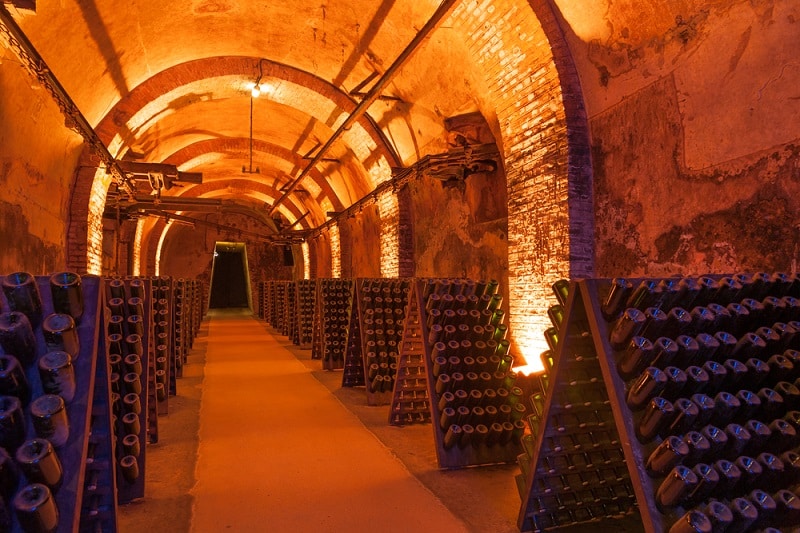
Chardonnay: A white grape variety that contributes elegance, finesse, and freshness to Champagne. This fabulous wine is found in Côte des Blancs and other areas with chalky soils.
Pinot Noir: A red grape variety that adds structure, body, and red fruit flavours to Champagne. It is prominent in the Montagne de Reims and other northern areas.
Pinot Meunier: Another red grape variety, Pinot Meunier produces fruitier and more approachable Champagnes. It is widely planted in Marne Valley and other areas with clay soils.
Champagne Production: Champagne is produced using the traditional method (Méthode Champenoise), where the secondary fermentation that creates the bubbles occurs. Non-vintage Champagne is a blend from multiple years, providing consistency in style. Vintage Champagne is produced in exceptional years and reflects the unique characteristics of a specific vintage. Blanc de Blancs uses white grapes, usually Chardonnay while Blanc de Noirs uses red grapes (Pinot Noir or Pinot Meunier). These terms indicate the grape colour.
The Champagne region is divided into several sub-regions, including the Montagne de Reims, Côte des Blancs, Vallée de la Marne, and the Côte des Bar. Each sub-region grows specific grapes. Many Champagne houses produce prestige cuvées, which are their top-of-the-line offerings. Examples include Dom Pérignon, Krug, and Louis Roederer’s Cristal.
Historical Heritage at Veuve Clicquot
Still, on Champagne, you need to know about Veuve Clicquot, a renowned Champagne house in Reims, France, established in the 18th century by Philippe Clicquot-Muiron. As a prestigious and well-known Champagne producer, the brand is of high quality with a long history of innovation and excellence in the Champagne industry.
The term “Veuve” translates to “widow” in French. It was later used to recognize the role of Madame Barbe-Nicole Clicquot, the widow of François Clicquot, who took over the business in 1805 after her husband’s death. Barbe-Nicole Ponsardin, also known as Madame Clicquot, played a crucial role. She is credited with several innovations, including developing the first recorded vintage Champagne in 1810.
Veuve Clicquot offers distinct Champagne styles with balanced richness, depth, and finesse. The Champagnes often exhibit vibrant acidity, a fine mousse (bubbles), and a combination of fruit and toasty notes. The Non vintage Yellow Label, a globally iconic, highly recognizable Champagne blends grapes from several years to achieve consistent styles. Veuve Clicquot produces Champagnes, including vintage releases and prestige cuvées. Prestige cuvées, such as La Grande Dame, are top-tier Champagnes crafted from the finest grapes and are typically aged for an extended period.
Delicious Wines from The French Region of Bordeaux
Bordeaux’s most prestigious and renowned wine-producing areas in southwest France excel in everything. Bottles feature quality, complexity, and the ability to age gracefully, and anything from Chateau Margaux comes highly recommended, although many wine experts say anything from the 20th century is perfect. Don’t forget that Bordeaux is said to be the capital of red wine, and this says it all.
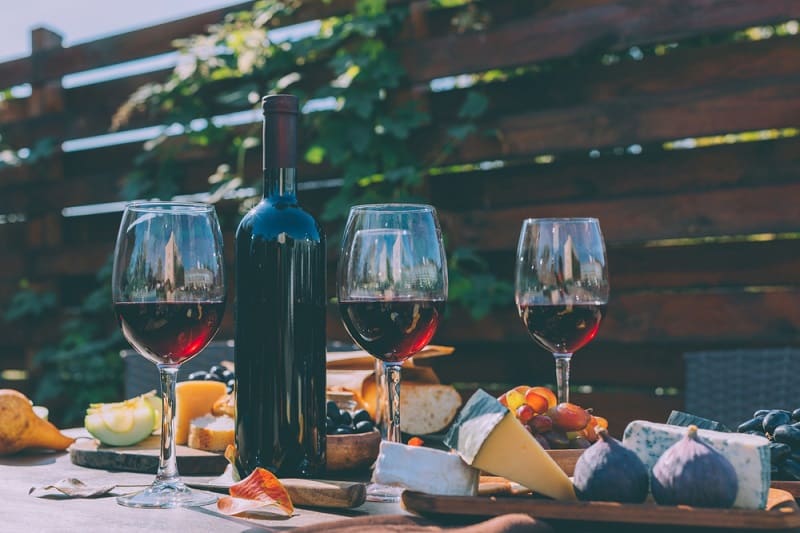
Red Grapes: Earning fame for structure, tannins, and ageing potential, the Cabernet Sauvignon grape dominates in wines from the Left Bank appellations like Pauillac and Margaux. While the Merlot is a significant component in wines from the Right Bank, like Saint-Émilion and Pomerol. Cabernet Franc adds floral and herbal notes and is found in blends, especially on the Right Bank. Petit Verdot and Malbec are lesser-known Bordeaux grapes used in some blends to add complexity and character.
White Grapes: Offering vibrant acidity and citrusy flavours, Sauvignon Blanc is often part of blends in dry white wines from the Graves region. Sémillon adds body, richness, and a honeyed character. It is found in both dry and sweet white Bordeaux wines. Muscadelle, a less everyday grape used in small amounts, contributes floral and aromatic qualities.
Bordeaux Classification System: Bordeaux’s classification system ranks certain estates or châteaux based on perceived quality. The most famous classification is the 1855 Classification of the Médoc and Graves, which includes five levels (from first to fifth growths) based on the châteaux’s reputation at the time.
Left Bank and Right Bank: Bordeaux is often divided into two central regions: the Left Bank (west of the Gironde River) and the Right Bank (east of the Gironde). The Left Bank produces Cabernet Sauvignon-dominant blends, while the Right Bank often features Merlot as the predominant grape.
Bordeaux Sub-Appellations: Bordeaux has several sub-appellations, each with a distinct terroir and style. Notable sub-regions include:
- Médoc: Known for Cabernet Sauvignon-based wines, including famous appellations like Pauillac and Margaux.
- Saint-Émilion and Pomerol: Prominent Right Bank appellations known for Merlot-dominant wines with a focus on elegance and finesse.
- Graves: Produces red and white bottles, with a reputation for the dry whites of Pessac-Léognan and the reds of Haut-Médoc.
- Sauternes: Famous for sweet, botrytized white wines, characterized by appellations like Château d’Yquem.
Bordeaux Wine Styles: Red Bordeaux is typically characterized by dark fruit flavours, cassis, cedar, and, in more mature wines, secondary notes like leather and tobacco. Dry White Bordeaux can range from crisp and citrusy to decadent and tropical, depending on the blend of Sauvignon Blanc, Sémillon, and Muscadelle. Sauternes and Barsac are renowned for their sweet, botrytized white wines with honey, apricot, and marmalade flavours.
The Provence Region of France
Provence, a historic and picturesque region bordering the Mediterranean Sea in southeastern France, features stunning landscapes and charming villages. With a Mediterranean climate, it is also a significant wine-producing area. The Chateau La Coste earns countrywide fame here, but many historic villages are connected to the wine industry. Featuring the French Alps to the north, famous cities include Marseille, Aix-en-Provence, and Avignon, and the hot, dry summers and mild winters are conducive to grape growing.
Grape Varieties: Provence is particularly famous for dry rosé wines, which account for significant portions of production. The primary grapes used for rosé include Grenache, Cinsault, Syrah, and Mourvèdre. While rosé is dominant, Provence also produces red and white wines. Red wines are often from Grenache, Syrah, Mourvèdre, and Carignan. White wines are crafted from grapes like Vermentino (Rolle), Ugni Blanc, and Clairette.
Appellations: Provence has several AOC (Appellation d’Origine Contrôlée) designations that define specific wine-producing areas and set standards for grape growing and winemaking. Some notable appellations include:
- Côtes de Provence: The largest and most well-known appellation in Provence, producing rosé, red, and white bottles.
- Coteaux d’Aix-en-Provence: Excelling in red, white, and rosé, this appellation is characterized by limestone soils and various grapes.
- Coteaux Varois en Provence: An appellation in the Var department with a diverse range of wines, including rosé, red, and white.
- Provence is globally recognized as a leading producer of high-quality rosé wines. Provencal rosé is typically dry, pale in colour, and offers refreshing acidity. Wines often exhibit flavours of red berries, citrus, and floral notes.
The World of Wine-Producing Chateaus
France features numerous prestigious châteaux that produce world-class bottles. These estates, often with historical significance and architectural splendour, are scattered throughout the country. If you are looking for a decent bottle, watch out for wines from the following;
- Bordeaux: Chateau Margaux, Château Lafite Rothschild, Château Latour and Château d’Yquem produce exceptional sweet bottles, particularly Sauternes.
- Burgundy: Domaine de la Romanée-Conti is home to Grand Cru vineyard Romanée-Conti, producing exceptional Pinot Noir. Château de la Tour (Clos Vougeot) offers high-quality Grand Cru red Burgundies, primarily Pinot Noir, and reflects the essence of the Côte de Nuits terroir.
- Champagne: Dom Perigon, named after a Benedictine monk, is considered a pioneer in Champagne production and part of the Moët & Chandon portfolio. Krug is also a prestigious Champagne house that focuses on craftsmanship and individuality.
- Loire Valley: Domaine de la Romanée-Conti offers several expressions showcasing the versatility of the Chenin Blanc grape.
- Alsace: Domaine Zind-Humbrecht is a highly regarded estate in Alsace using biodynamic practices. They produce diverse Alsatian bottles, including Riesling, Gewürztraminer, and Pinot Gris. These châteaux represent just a fraction of many exceptional wine estates across France.
Organic Wine in the Languedoc region
In southern France along the Mediterranean coast, the Languedoc region ranges from diverse landscapes and historic sites to wine production, but more notably organic wines, of which French wine producers have taken the processing one step further.
The area’s vast vineyards span diverse terroirs, allowing the cultivation of several grapes. The diverse geography includes the rugged terrain of the Cévennes mountains, the vineyard-covered plains, and the beautiful Mediterranean coast beaches. The Canal du Midi, a UNESCO World Heritage Site, also runs through Languedoc, adding to its scenic allure.
Savoie and Ski Chalet Wines
There is a saying that Savoie wine is perfect for the end of the day in a ski chalet, which refers to the mountainous location. Savoie, also called Savoy, in eastern France, nestled in the Alpine foothills near the border with Switzerland, is one of the lesser-known wine regions. But this picturesque area, characterized by stunning landscapes, mountainous terrain, and pristine lakes, also earns fame for the alpine living.
The wines of Savoie are often overshadowed by those of more well-known French regions. Still, they have a unique charm and character and perfectly complement the wine cellars in your ski chalet. The diverse soil types include limestone, marl, schist, and gravel, contributing to the uniqueness of Savoie wines.
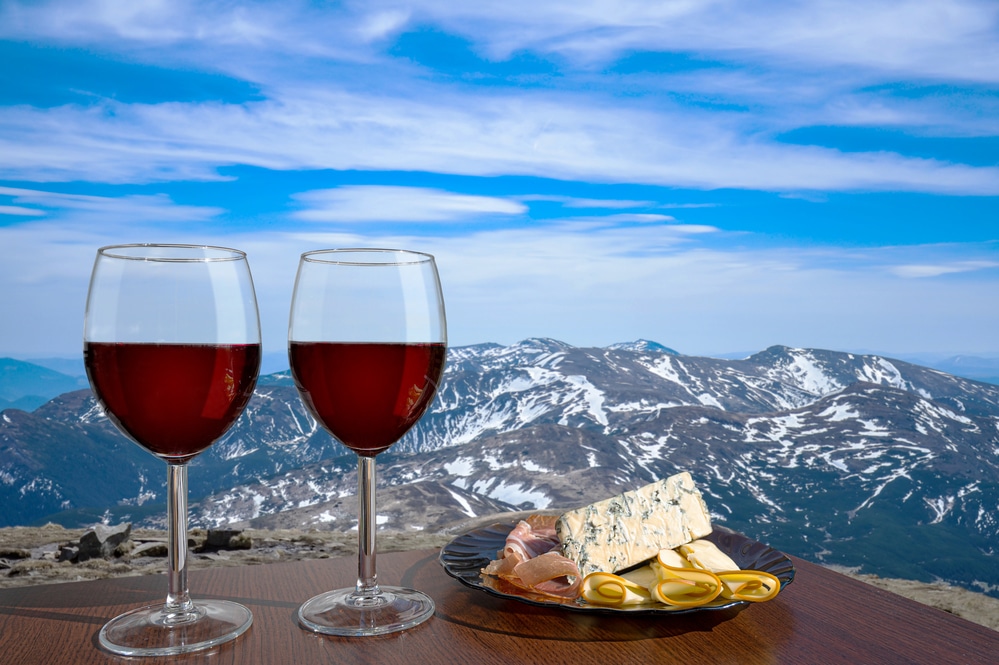
Savoie’s most prominent white grapes include Jacquère (the most widely planted), Altesse (also known as Roussette), Chasselas, and Gringet. Mondeuse is Savoie’s flagship red grape, producing red wines with lively acidity and vibrant fruit flavours. Gamay, Pinot Noir, and Persan are also grown. Jacquère is the workhorse grape for dry whites, producing wines with notes of green apples, citrus, and a mineral edge.
Altesse/Roussette is often used for more prosperous and more complex white wines. Mondeuse is the critical red grape, yielding wines with red fruit flavours, peppery notes, and a medium-bodied structure. The reds can be vibrant and approachable or more structured for ageing. Roussette de Savoie wines include aromatic complexity and the ability to age.
Growing grapes in Savoie vineyards can be challenging due to steep slopes and varying altitudes. While Savoie may be less well-known than some of France’s more significant wine regions, the distinctive Alpine character reflects the terroir and traditions of this charming region.
More About France
We hope we have given you more than enough ideas of the best wine regions in France so you can stock up your wine cellars with bountiful bottles. From the famous French wine regions of Bordeaux and Burgundy to the lesser-known but still delightful Alsace, the quality of wines never fails to delight.
However, after a day skiing on the slopes, you might like to pair them with lovely Savoie food. In which case, this article will interest you. From historical heritage to medieval villages and the quality of wines, the Savoie region and the Alps are dream destinations. So while, France excels in wine producing areas, it is also home to the best ski resorts in the world, and what a fantastic holiday that would be. Combining ski and snow, with food and wine.

